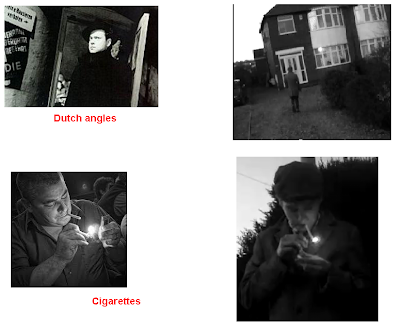To some extent, my film follows all these theories. Obviously there is a beginning, a middle and an end. As my film is only 5 minutes long, it doesn't have enough time to progress through all 5 stages of equilibrium. As the film results in the death of 2 characters, equilibrium is not restored, and therefore is no new equilibrium.
The character types in my film according to propp's theory are:
In terms of Film Noir, my film follows the codes and conventions as accurately as I could of made it.
I shot my film in black and white, a basic convention of Film Noir. I based the character types (corrupt detectives and criminals) on archetypes built by the noir genre. I tried to imitate the lighting as best as i could. All indoor shots had a portable lamp positioned behind shot, aiming on the scene that was being filmed. This created lots of shadows, another staple of the genre. Shadows help to build the mysterious atmosphere associated with Noir. The music included was jazz, which is featured heavily in noir. This is to create a smooth, sophisticated and dark feel to the film. I used dutch angles to attempt to create an air of disorientation, another common technique. However, to some people unfamiliar with the genre, they may interpret tilted angles as bad camera work. I included noticeable iconography in the mise-en-scene and the characters costumes, such as suits, cigarettes, trilbys and alcohol. One way in which i challenged the conventions was the choice to set it in a more rural, quieter suburb. This is a contrast to most noir, set in large, neon lit cities.
Here is a visual chart of how I stuck to codes and conventions of film noir:
The character types in my film according to propp's theory are:
- The Detective - The false hero (He's the protagonist, but he's not a hero as he's quite corrupt.)
- New detective - The helper (Tries to help the detective solve a case, but ends up getting killed.)
- Crime bosses - Villains (Paying money for the detective to murder someone)
As none of my characters are "good", it means there is no obvious hero. The closest there is to that is the new detective, but he is not prominent enough to earn such a title. Binary oppositions in my film include good and evil and morality and immorality.
In terms of Film Noir, my film follows the codes and conventions as accurately as I could of made it.
I shot my film in black and white, a basic convention of Film Noir. I based the character types (corrupt detectives and criminals) on archetypes built by the noir genre. I tried to imitate the lighting as best as i could. All indoor shots had a portable lamp positioned behind shot, aiming on the scene that was being filmed. This created lots of shadows, another staple of the genre. Shadows help to build the mysterious atmosphere associated with Noir. The music included was jazz, which is featured heavily in noir. This is to create a smooth, sophisticated and dark feel to the film. I used dutch angles to attempt to create an air of disorientation, another common technique. However, to some people unfamiliar with the genre, they may interpret tilted angles as bad camera work. I included noticeable iconography in the mise-en-scene and the characters costumes, such as suits, cigarettes, trilbys and alcohol. One way in which i challenged the conventions was the choice to set it in a more rural, quieter suburb. This is a contrast to most noir, set in large, neon lit cities.
Here is a visual chart of how I stuck to codes and conventions of film noir:













